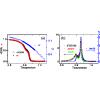当前位置:
X-MOL 学术
›
Phys. Rev. B
›
论文详情
Our official English website, www.x-mol.net, welcomes your
feedback! (Note: you will need to create a separate account there.)
Cross derivative of the Gibbs free energy: A universal and efficient method for phase transitions in classical spin models
Physical Review B ( IF 3.2 ) Pub Date : 2020-04-20 , DOI: 10.1103/physrevb.101.165123 Y. Chen , K. Ji , Z. Y. Xie , J. F. Yu
Physical Review B ( IF 3.2 ) Pub Date : 2020-04-20 , DOI: 10.1103/physrevb.101.165123 Y. Chen , K. Ji , Z. Y. Xie , J. F. Yu

|
With an auxiliary weak external magnetic field, we reexamine the fundamental thermodynamic function, Gibbs free energy , to study phase transitions in classical spin lattice models. A cross derivative, i.e., the second-order partial derivative of with respect to both temperature and field, is calculated to precisely locate the critical temperature, which also reveals the nature of a transition. The strategy is efficient and universal, as exemplified by the five-state clock model, two-dimensional (2D) and 3D Ising models, and the model, no matter if a transition is trivial or exotic with complex excitations. More importantly, other conjugate pairs could also be integrated into a similar cross derivative if necessary, which would greatly enrich our vision and means to investigate phase transitions both theoretically and experimentally.
中文翻译:

吉布斯自由能的交叉导数:经典自旋模型中相变的通用有效方法
在辅助弱外部磁场的作用下,我们重新检查了基本的热力学函数吉布斯自由能 研究经典自旋晶格模型中的相变。交叉导数,即...的二阶偏导数相对于温度和磁场,可以精确地确定临界温度,这也揭示了过渡的性质。该策略高效且通用,例如五态时钟模型,二维(2D)和3D Ising模型,以及模型,无论过渡是微不足道的还是复杂的激发。更重要的是,如果需要的话,其他共轭对也可以整合到类似的交叉导数中,这将极大地丰富我们的视野以及研究理论和实验相变的手段。
更新日期:2020-04-20
中文翻译:

吉布斯自由能的交叉导数:经典自旋模型中相变的通用有效方法
在辅助弱外部磁场的作用下,我们重新检查了基本的热力学函数吉布斯自由能 研究经典自旋晶格模型中的相变。交叉导数,即...的二阶偏导数相对于温度和磁场,可以精确地确定临界温度,这也揭示了过渡的性质。该策略高效且通用,例如五态时钟模型,二维(2D)和3D Ising模型,以及模型,无论过渡是微不足道的还是复杂的激发。更重要的是,如果需要的话,其他共轭对也可以整合到类似的交叉导数中,这将极大地丰富我们的视野以及研究理论和实验相变的手段。

































 京公网安备 11010802027423号
京公网安备 11010802027423号